Robert K. Katzschmann
Soft Robotics Lab, IRIS, D-MAVT, ETH Zurich, Switzerland
SORS: A Modular, High-Fidelity Simulator for Soft Robots
Dec 17, 2025Abstract:The deployment of complex soft robots in multiphysics environments requires advanced simulation frameworks that not only capture interactions between different types of material, but also translate accurately to real-world performance. Soft robots pose unique modeling challenges due to their large nonlinear deformations, material incompressibility, and contact interactions, which complicate both numerical stability and physical accuracy. Despite recent progress, robotic simulators often struggle with modeling such phenomena in a scalable and application-relevant manner. We present SORS (Soft Over Rigid Simulator), a versatile, high-fidelity simulator designed to handle these complexities for soft robot applications. Our energy-based framework, built on the finite element method, allows modular extensions, enabling the inclusion of custom-designed material and actuation models. To ensure physically consistent contact handling, we integrate a constrained nonlinear optimization based on sequential quadratic programming, allowing for stable and accurate modeling of contact phenomena. We validate our simulator through a diverse set of real-world experiments, which include cantilever deflection, pressure-actuation of a soft robotic arm, and contact interactions from the PokeFlex dataset. In addition, we showcase the potential of our framework for control optimization of a soft robotic leg. These tests confirm that our simulator can capture both fundamental material behavior and complex actuation dynamics with high physical fidelity. By bridging the sim-to-real gap in these challenging domains, our approach provides a validated tool for prototyping next-generation soft robots, filling the gap of extensibility, fidelity, and usability in the soft robotic ecosystem.
Decoupling Torque and Stiffness: A Unified Modeling and Control Framework for Antagonistic Artificial Muscles
Nov 13, 2025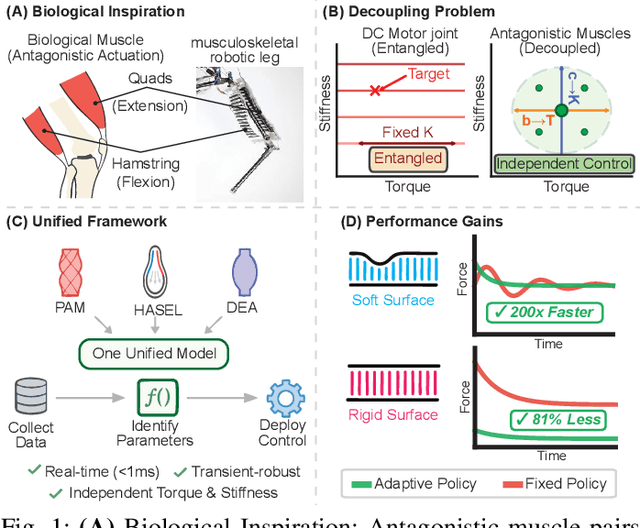

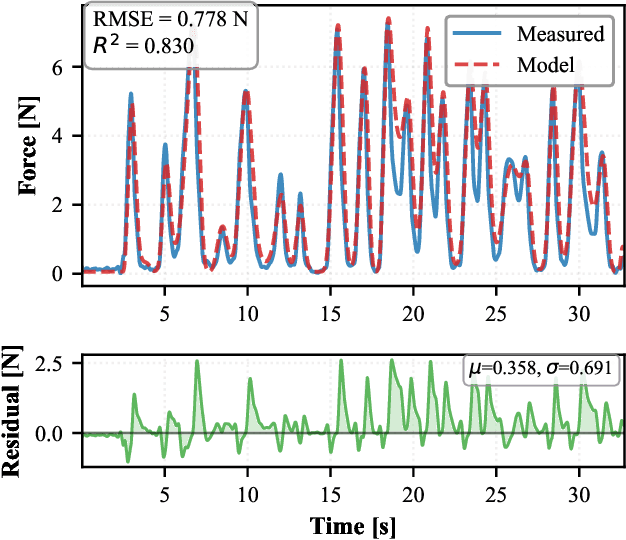
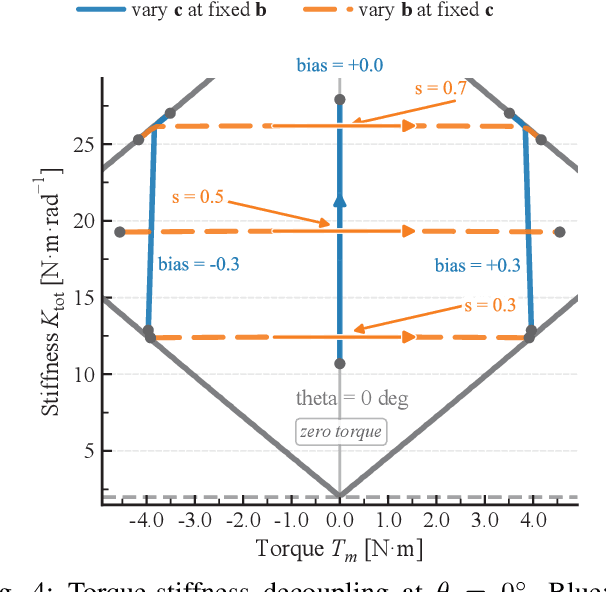
Abstract:Antagonistic soft actuators built from artificial muscles (PAMs, HASELs, DEAs) promise plant-level torque-stiffness decoupling, yet existing controllers for soft muscles struggle to maintain independent control through dynamic contact transients. We present a unified framework enabling independent torque and stiffness commands in real-time for diverse soft actuator types. Our unified force law captures diverse soft muscle physics in a single model with sub-ms computation, while our cascaded controller with analytical inverse dynamics maintains decoupling despite model errors and disturbances. Using co-contraction/bias coordinates, the controller independently modulates torque via bias and stiffness via co-contraction-replicating biological impedance strategies. Simulation-based validation through contact experiments demonstrates maintained independence: 200x faster settling on soft surfaces, 81% force reduction on rigid surfaces, and stable interaction vs 22-54% stability for fixed policies. This framework provides a foundation for enabling musculoskeletal antagonistic systems to execute adaptive impedance control for safe human-robot interaction.
Learning Soft Robotic Dynamics with Active Exploration
Oct 31, 2025Abstract:Soft robots offer unmatched adaptability and safety in unstructured environments, yet their compliant, high-dimensional, and nonlinear dynamics make modeling for control notoriously difficult. Existing data-driven approaches often fail to generalize, constrained by narrowly focused task demonstrations or inefficient random exploration. We introduce SoftAE, an uncertainty-aware active exploration framework that autonomously learns task-agnostic and generalizable dynamics models of soft robotic systems. SoftAE employs probabilistic ensemble models to estimate epistemic uncertainty and actively guides exploration toward underrepresented regions of the state-action space, achieving efficient coverage of diverse behaviors without task-specific supervision. We evaluate SoftAE on three simulated soft robotic platforms -- a continuum arm, an articulated fish in fluid, and a musculoskeletal leg with hybrid actuation -- and on a pneumatically actuated continuum soft arm in the real world. Compared with random exploration and task-specific model-based reinforcement learning, SoftAE produces more accurate dynamics models, enables superior zero-shot control on unseen tasks, and maintains robustness under sensing noise, actuation delays, and nonlinear material effects. These results demonstrate that uncertainty-driven active exploration can yield scalable, reusable dynamics models across diverse soft robotic morphologies, representing a step toward more autonomous, adaptable, and data-efficient control in compliant robots.
Beyond Anthropomorphism: Enhancing Grasping and Eliminating a Degree of Freedom by Fusing the Abduction of Digits Four and Five
Sep 16, 2025Abstract:This paper presents the SABD hand, a 16-degree-of-freedom (DoF) robotic hand that departs from purely anthropomorphic designs to achieve an expanded grasp envelope, enable manipulation poses beyond human capability, and reduce the required number of actuators. This is achieved by combining the adduction/abduction (Add/Abd) joint of digits four and five into a single joint with a large range of motion. The combined joint increases the workspace of the digits by 400\% and reduces the required DoFs while retaining dexterity. Experimental results demonstrate that the combined Add/Abd joint enables the hand to grasp objects with a side distance of up to 200 mm. Reinforcement learning-based investigations show that the design enables grasping policies that are effective not only for handling larger objects but also for achieving enhanced grasp stability. In teleoperated trials, the hand successfully performed 86\% of attempted grasps on suitable YCB objects, including challenging non-anthropomorphic configurations. These findings validate the design's ability to enhance grasp stability, flexibility, and dexterous manipulation without added complexity, making it well-suited for a wide range of applications.
Latent Action Diffusion for Cross-Embodiment Manipulation
Jun 17, 2025Abstract:End-to-end learning approaches offer great potential for robotic manipulation, but their impact is constrained by data scarcity and heterogeneity across different embodiments. In particular, diverse action spaces across different end-effectors create barriers for cross-embodiment learning and skill transfer. We address this challenge through diffusion policies learned in a latent action space that unifies diverse end-effector actions. We first show that we can learn a semantically aligned latent action space for anthropomorphic robotic hands, a human hand, and a parallel jaw gripper using encoders trained with a contrastive loss. Second, we show that by using our proposed latent action space for co-training on manipulation data from different end-effectors, we can utilize a single policy for multi-robot control and obtain up to 13% improved manipulation success rates, indicating successful skill transfer despite a significant embodiment gap. Our approach using latent cross-embodiment policies presents a new method to unify different action spaces across embodiments, enabling efficient multi-robot control and data sharing across robot setups. This unified representation significantly reduces the need for extensive data collection for each new robot morphology, accelerates generalization across embodiments, and ultimately facilitates more scalable and efficient robotic learning.
mimic-one: a Scalable Model Recipe for General Purpose Robot Dexterity
Jun 13, 2025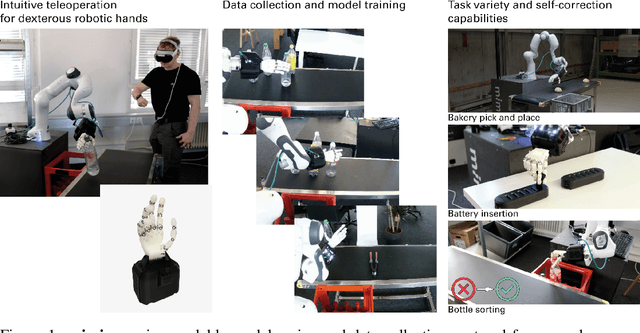
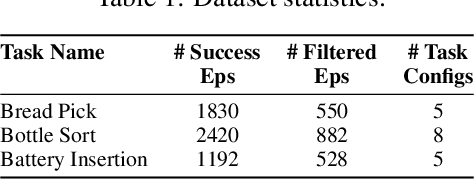

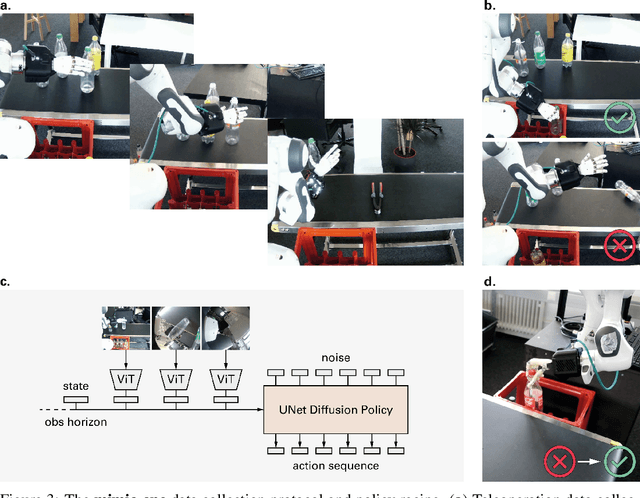
Abstract:We present a diffusion-based model recipe for real-world control of a highly dexterous humanoid robotic hand, designed for sample-efficient learning and smooth fine-motor action inference. Our system features a newly designed 16-DoF tendon-driven hand, equipped with wide angle wrist cameras and mounted on a Franka Emika Panda arm. We develop a versatile teleoperation pipeline and data collection protocol using both glove-based and VR interfaces, enabling high-quality data collection across diverse tasks such as pick and place, item sorting and assembly insertion. Leveraging high-frequency generative control, we train end-to-end policies from raw sensory inputs, enabling smooth, self-correcting motions in complex manipulation scenarios. Real-world evaluations demonstrate up to 93.3% out of distribution success rates, with up to a +33.3% performance boost due to emergent self-correcting behaviors, while also revealing scaling trends in policy performance. Our results advance the state-of-the-art in dexterous robotic manipulation through a fully integrated, practical approach to hardware, learning, and real-world deployment.
MAPLE: Encoding Dexterous Robotic Manipulation Priors Learned From Egocentric Videos
Apr 08, 2025

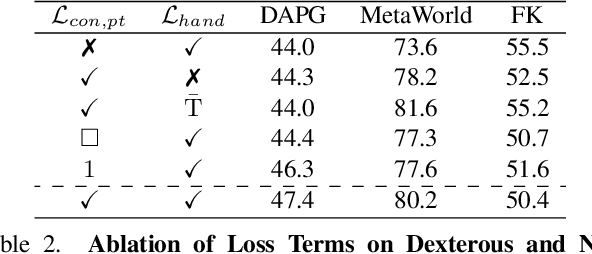
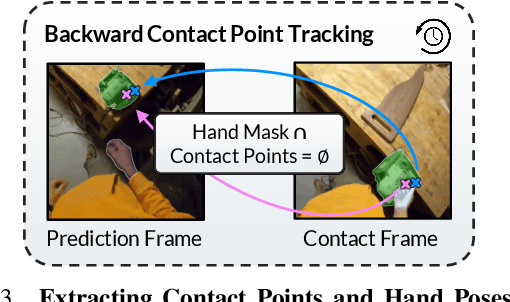
Abstract:Large-scale egocentric video datasets capture diverse human activities across a wide range of scenarios, offering rich and detailed insights into how humans interact with objects, especially those that require fine-grained dexterous control. Such complex, dexterous skills with precise controls are crucial for many robotic manipulation tasks, yet are often insufficiently addressed by traditional data-driven approaches to robotic manipulation. To address this gap, we leverage manipulation priors learned from large-scale egocentric video datasets to improve policy learning for dexterous robotic manipulation tasks. We present MAPLE, a novel method for dexterous robotic manipulation that exploits rich manipulation priors to enable efficient policy learning and better performance on diverse, complex manipulation tasks. Specifically, we predict hand-object contact points and detailed hand poses at the moment of hand-object contact and use the learned features to train policies for downstream manipulation tasks. Experimental results demonstrate the effectiveness of MAPLE across existing simulation benchmarks, as well as a newly designed set of challenging simulation tasks, which require fine-grained object control and complex dexterous skills. The benefits of MAPLE are further highlighted in real-world experiments using a dexterous robotic hand, whereas simultaneous evaluation across both simulation and real-world experiments has remained underexplored in prior work.
ORCA: An Open-Source, Reliable, Cost-Effective, Anthropomorphic Robotic Hand for Uninterrupted Dexterous Task Learning
Apr 05, 2025

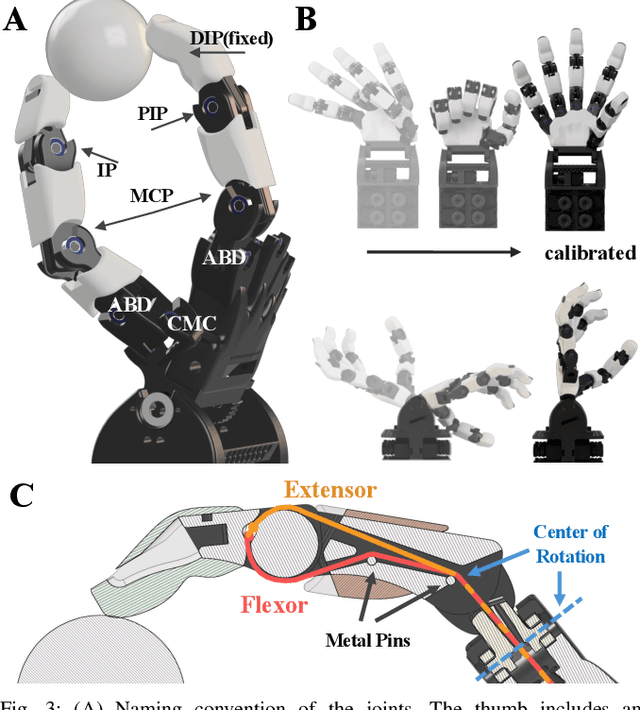
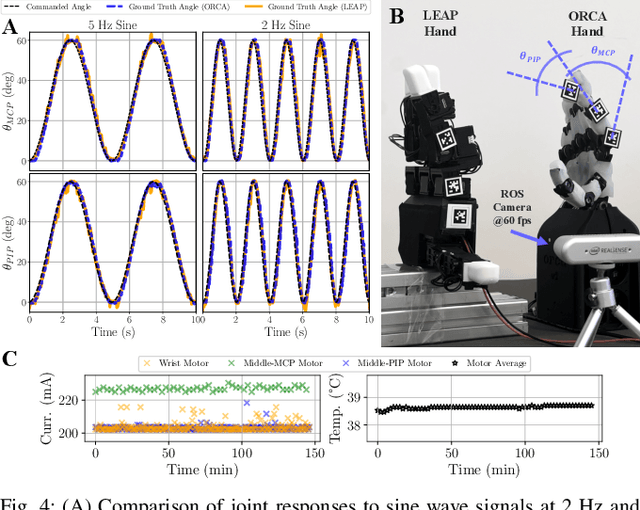
Abstract:General-purpose robots should possess humanlike dexterity and agility to perform tasks with the same versatility as us. A human-like form factor further enables the use of vast datasets of human-hand interactions. However, the primary bottleneck in dexterous manipulation lies not only in software but arguably even more in hardware. Robotic hands that approach human capabilities are often prohibitively expensive, bulky, or require enterprise-level maintenance, limiting their accessibility for broader research and practical applications. What if the research community could get started with reliable dexterous hands within a day? We present the open-source ORCA hand, a reliable and anthropomorphic 17-DoF tendon-driven robotic hand with integrated tactile sensors, fully assembled in less than eight hours and built for a material cost below 2,000 CHF. We showcase ORCA's key design features such as popping joints, auto-calibration, and tensioning systems that significantly reduce complexity while increasing reliability, accuracy, and robustness. We benchmark the ORCA hand across a variety of tasks, ranging from teleoperation and imitation learning to zero-shot sim-to-real reinforcement learning. Furthermore, we demonstrate its durability, withstanding more than 10,000 continuous operation cycles - equivalent to approximately 20 hours - without hardware failure, the only constraint being the duration of the experiment itself. All design files, source code, and documentation will be available at https://www.orcahand.com/.
Model-Based Capacitive Touch Sensing in Soft Robotics: Achieving Robust Tactile Interactions for Artistic Applications
Mar 04, 2025Abstract:In this paper, we present a touch technology to achieve tactile interactivity for human-robot interaction (HRI) in soft robotics. By combining a capacitive touch sensor with an online solid mechanics simulation provided by the SOFA framework, contact detection is achieved for arbitrary shapes. Furthermore, the implementation of the capacitive touch technology presented here is selectively sensitive to human touch (conductive objects), while it is largely unaffected by the deformations created by the pneumatic actuation of our soft robot. Multi-touch interactions are also possible. We evaluated our approach with an organic soft robotics sculpture that was created by a visual artist. In particular, we evaluate that the touch localization capabilities are robust under the deformation of the device. We discuss the potential this approach has for the arts and entertainment as well as other domains.
* 8 pages, 17 figures. Accepted at IEEE Robotics and Automation Letters (RA-L) 2025
Rotograb: Combining Biomimetic Hands with Industrial Grippers using a Rotating Thumb
Dec 04, 2024Abstract:The development of robotic grippers and hands for automation aims to emulate human dexterity without sacrificing the efficiency of industrial grippers. This study introduces Rotograb, a tendon-actuated robotic hand featuring a novel rotating thumb. The aim is to combine the dexterity of human hands with the efficiency of industrial grippers. The rotating thumb enlarges the workspace and allows in-hand manipulation. A novel joint design minimizes movement interference and simplifies kinematics, using a cutout for tendon routing. We integrate teleoperation, using a depth camera for real-time tracking and autonomous manipulation powered by reinforcement learning with proximal policy optimization. Experimental evaluations demonstrate that Rotograb's rotating thumb greatly improves both operational versatility and workspace. It can handle various grasping and manipulation tasks with objects from the YCB dataset, with particularly good results when rotating objects within its grasp. Rotograb represents a notable step towards bridging the capability gap between human hands and industrial grippers. The tendon-routing and thumb-rotating mechanisms allow for a new level of control and dexterity. Integrating teleoperation and autonomous learning underscores Rotograb's adaptability and sophistication, promising substantial advancements in both robotics research and practical applications.
 Add to Chrome
Add to Chrome Add to Firefox
Add to Firefox Add to Edge
Add to Edge